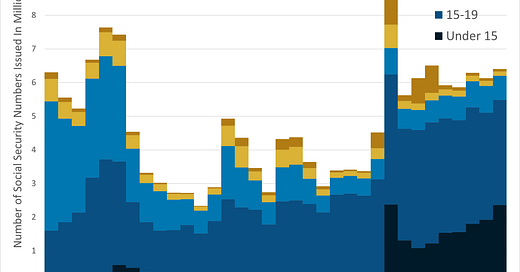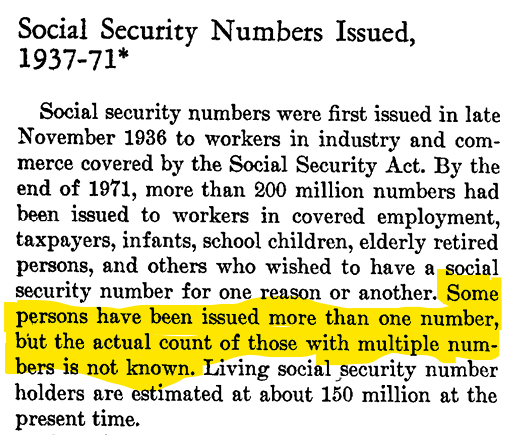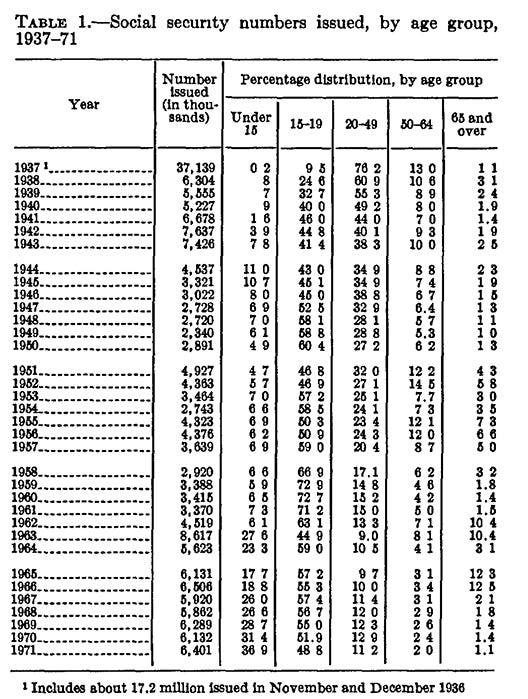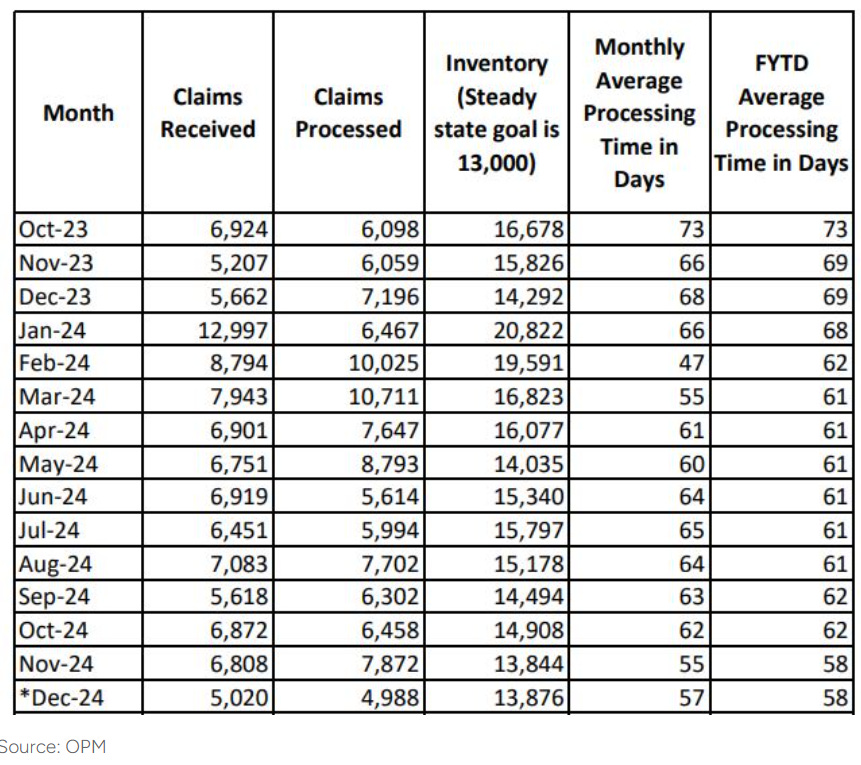A Potential Large Source of Junk SSA Data: The Pre-1972 Social Security Number Process
This is true geeking out stuff, and no, it doesn't involve fraud (necessarily)
Know your data.
I have said this many times. Data are created via some sort of process, and knowing that process is going to help you understand what you’re looking at now.
When we’re considering a set of data that has tens of millions of too many supposedly-living people, there are many potential explanations.
Some people went straight for a fraud explanation. Others went for the explanation of a COBOL default. By the way, the answer isn’t COBOL.
Pre-1972 Social Security Number Process
But it may be a lot simpler than you think: before 1972, a lot of people had duplicate SSNs (Social Security Numbers) because of the process of how you got them, and what happened if you lost your Social Security card with the number on it.
You went to a local office to get a new card… which had a new number on it. And no, there wasn’t cross-referencing with your prior SSN. That was kind of on you (and you just lost your number/card.)
In 1972, the SSA (Social Security Administration) realized there was becoming a real mess by having their hundreds of field offices independently handing out numbers that had transformed into becoming an identity number for tax purposes… and so many other purposes. So now all SSNs would be centrally controlled from the SSA’s HQ in Baltimore.
But you don’t have to take my word for it.
Let’s look at the Social Security Bulletin, which has a few articles on the history and statistics over this period.
Social Security Numbers Issuance History, 1937-1971
Social Security Numbers Issued, 1937–71 by Herbert R. Tacker
Social Security Bulletin Vol. 35, No. 7 (July 1972)
Opening paragraph:
I will get to the tables of issued numbers in a bit, but I cannot use the numbers given to try to estimate the number of duplicates. For the period given, many people didn’t have SSNs at all.
Note that what is being described is completely legal. There was nothing seen as wrong with having more than one SSN, because it wasn’t intended to be used to identify a person at the time.
As long as a person could assemble all their SSNs for an earnings record, there should be no problem… right? It would be okay if one person had multiple SSNs.
It would not be okay for multiple people to use the same SSN.
But then the usage of SSNs expanded.
Okay, enough pre-1972 narrative. Let’s look at the issuance in totals and age distribution.
Overall issuance 1937-1971, by Age Group
Here is the Table:
And here is the graph (I excluded 1937, as the initial year dwarfed subsequent years):
You can see the spike in 1963 after the IRS began its special form 3227.
As noted in the text, you can see the increase in applications of those over the age of 65, so they could participate in Medicare. Plenty of people, like stay-at-home wives, might not have SSNs, and would need to get one to participate in the newly-created program.
Also notice the growth in youth applications for SSNs. Now we’re used to babies getting SSNs soon after they’re born (awww, mama’s little tax deduction!) But that was something that came in the 1980s. To be sure, that shift also came in 1963, as you can see.
For the most part, people had been applying for SSNs with their first jobs, around ages 15-19.
Some of those older age applications once the program had been around some years could be the origin of duplicate records.
A Story to Explain How We Get the “Living Dead” in Some Data
So if we revisit this table:

Again, there is no evidence of a COBOL default that leads to a spike of ages at 150. It looks like there may be a block of people with birth years of 1800, though (age 225).
That said, the few million of records of age 120 and older may be a result of those duplicates created in the 1937-1971 era.
Let’s say somebody was born in 1890 (such as one of my great-grandparents). He gets his first SSN in 1937, when everybody rushes to get it, and he’s 47. So far, so good.
But then comes WWII, and with one thing and another, he loses his first Social Security card and number. It’s a new thing. He doesn’t necessarily keep good track of it. So he goes to the local office and gets a new one.
By the way, if you’d like to understand a bit more about SSNs, here is this old article: Meaning of the Social Security Number, by Erma Barron and Felix Bamberger, Social Security Bulletin, November 1982, Vol. 45, No. 11.
So this theoretical person can have had two SSNs, and when he ultimately retires, maybe he gets his work history straightened out over being under two different SSNs… or maybe he doesn’t and just takes what he gets from the second one.
When he dies - suppose at the hearty age of 85, in 1975 - his death is reported to the SSA, and whatever benefit he was receiving under that second SSN stops. He is entered as dead. Under that second SSN.
There is no cross-linking between these SSNs, so the first one keeps ticking up as “alive”, but it’s also not paying out benefits or doing anything.
And in 2025, a data extract spits out our theoretical person as being 135 years old, from the record of that first, long-lost and forgotten SSN. He never received benefits under that SSN.
By the way, this only explains some of the data anomalies in the table above. But the population anomalies at the “reasonable” ages under age 80 are more subtle to untangle.
For the really bizarre super-old ages, by the way, there can just be screwed-up manual data entry and total lack of data validation.
None of these are good things. It doesn’t require fraud. But just because it’s not fraud, doesn’t mean “Oh, well then, it’s all okay.”
Junk data and messy systems invite distrust, if not fraud
I have noticed a lot of people reading way more into the claims Elon Musk has made re: the Social Security Numbers, and there are two parts to it:
SSNs are being used as supposedly unique identifiers throughout all sorts of systems in government and private systems. Elon’s claims center on whether on can depend on the SSN database being at all reliable - there seems to be a lot of junk in there.
Social Security does pay out a huge amount per year. Elon Musk hasn’t made any claims about the payments that are substantial - I already showed the annual reports that have been going on for years now. The improper payments that they’ve detected (and I haven’t talked about clawback yet) — and some are underpayments — are about 0.8% of the programs.
A lot of people are taking umbrage at Elon Musk and his merry DOGEsters calling into question the integrity of the database, but for crying out loud, over 50 years ago they knew there were duplicate SSNs, didn’t quantify it, and never really cleaned that up. I assume they hoped it would just dissolve away.
But it didn’t — because yes, the people with the duplicates died, but the duplicates hung around because there was no process to clear those out.
And, frankly, that’s not the only problem in the numbers. That’s the easy part, because unused SSNs are not necessarily a problem.
But an untamed database where there are tens of millions of SSNs too many floating around “live” invites distrust into the system… a system that is going to have to get cut and/or boost taxes quite a bit. There will be a serious reckoning for Social Security within a decade, and having a big cloud hanging over it will not help.
It’s not just Social Security, of course, but the SSNs are being used for identity purposes in all sorts of programs.
To shift gears, Larry Correia has provided a little (adult-language-riven) description on types of audits, their purposes, and what’s involved: Educating the Stupid on How Audits Work In Real Life
So now, as a guy who used to be an auditor, who has defended companies from dozens of audits from different government agencies, I’ll try to correct some of your incredibly stupid NPC talking points you keep endlessly barfing up.
First off, you need to know there’s a difference between an outside audit and an internal audit. An outside audit is when somebody who isn’t part of your company comes in and checks your stuff. This could be one of the fifty something government agencies that audit people/businesses, or this could be an outside CPA firm making sure you are in compliance for some reason (like the company is publicly traded). I’ll talk more about what CPAs are in a minute.
That’s just part of the beginning. Reader beware, if you click through.
I am not an auditor, nor used to be one, but I have been on the receiving end of these at insurers. And I have done a lot of data reviews. I’ve shown y’all some of them, especially of mortality data through the pandemic, such as the case of the supposed excess cancer deaths in Connecticut (which had to do with an IBNR model that hadn’t been updated.) If you start seeing data problems everywhere in a system… you start distrusting results you see come out of it. No matter how much somebody says: “Don’t worry! We’ve always done it that way! It’s no big deal!”
Clean up the crap.
By the time the Social Security cuts come (for people like me, who are high-income) and tax increases come (again, for people like me), there had better be no systems running on COBOL and no SSN duplicates.
DOGE is not going scrape out trillions of dollars of savings from any of this. I assume they’re not that delusional (maybe they are, who knows).
But they probably do know that any major cuts that will have to come from Congress will only be made palatable if there is a system that works.
And it won’t come from people using paper files in a limestone mine in Pennsylvania. By the way, here is the latest update on that group’s backlog on processing federal worker retirements.
It looks like they had been making progress, but that is just embarrassing. That’s not 60 calendar days. That’s 60 business days.
Elon Musk didn’t create the SSN data troubles - he’s just pointing them out. They should get cleaned up.












DOGE posted this on X this afternoon:
"In 2020-2021, @SBAgov issued 3,095 loans, including PPP (Paycheck Protection Program) and EIDL (Economic Injury Disaster Loan), for $333M to borrowers over 115 years old who were still marked as alive in the Social Security database. In one case, a 157 years old individual received $36k in loans."
Elon Musk stated somewhere (I think in his most recent interview with Joe Rogan) that he thinks the biggest grift with all those excess social security numbers is in other programs. He said the systems aren't closely linked together, so if a social security number comes through as valid and not dead, that's good enough.
By the way, there are at least 3.4 million "people" in every 10 year age cohort from the 20s to the 140s.
This reminds me of that old joke "a billion here, a billion there, and soon you are talking real money". Of course when that joke first appeared, a billion was a noticeable amount of money even in the US government budget.